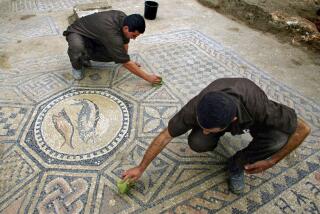Bowers Lands Rare Holy Land Relic
- Share via
The House of David Inscription, a rare relic of the Holy Land, will leave Israel to be displayed later this year at the Bowers Museum of Cultural Art in Santa Ana, in an exhibition that museum and Israeli cultural officials say is a first for a U.S. institution.
The exhibit, “The Holy Land: David Roberts, Dead Sea Scrolls, House of David Inscription,” will open Oct. 6.
It comes on the heels of a recent announcement that the Bowers expects to build long-term ties with the Smithsonian Institution and the British Museum. Bowers made headway last year in raising its profile with exhibits such as “Secret World of the Forbidden City: Splendors From China’s Imperial Palace,” and “Egyptian Treasures From The British Museum.”
The House of David Inscription, a sacred text carved in basalt stone that stands about 12 inches high and 8 1/2 inches wide, is the earliest mention of the House of David--and possibly of King David--outside of biblical texts. The inscription, discovered in 1993 in northern Israel, will be on loan from the Israel Museum.
“The House of David Inscription is the single most important artifact in the state of Israel and is a national treasure,” said Ran Boytner, an archeologist who, along with Lynn Swartz Dodd, is co-curator of traveling exhibition. “Before the inscription was found, there was the question, ‘Were David and Solomon mythical figures or real people?’ This may very well mean the House of David was not a biblical myth, but a historical fact.”
Archeologists found the three pieces of the House of David Inscription, also referred to as the Tel Dan Inscription. The Aramaic inscription was created about 950 BC as part of a victory stele erected by Hazael, king of Aram.
The inscription will accompany other objects, including the heel bone of a person believed to have been crucified, which is one of “the most important ones in our collection,” said Silvia Rozenberg, chief curator of archeology at the Israel Museum.
Two parchments of the Dead Sea Scrolls that date from the 3rd century BC to the 1st century will be loaned from the Israel Antiquities Authority for the show. The Dead Sea Scrolls are believed to be the oldest existing copies of the books of the Old Testament.
The two scrolls, discovered between 1947 and 1956 in caves on the northwestern shores of the Dead Sea, are among the most significant of the collection. The first is “The Psalms Scroll from Qumran,” which contains 41 canonized psalms--seven not found in the Bible; and the second is “War of the Sons of Light and the Sons of Darkness,” which describes an apocalyptic war according to the Dead Sea sect.
The exhibition, which will run simultaneously with another Bowers show, “The World of the Etruscans,” will also include 123 lithographs of the Holy Land by the Scottish artist David Roberts (1796-1864). Rifles and costumes similar to the ones Roberts immortalized in paintings made during his trip to the Holy Land in 1839 will be displayed.
Armand Labbe, director of research and collections at the Bowers, called the “The Holy Land” show a once-in-a-lifetime display.
“This is a unique opportunity to experience all of these works at a single venue,” he said.
More to Read
The biggest entertainment stories
Get our big stories about Hollywood, film, television, music, arts, culture and more right in your inbox as soon as they publish.
You may occasionally receive promotional content from the Los Angeles Times.










